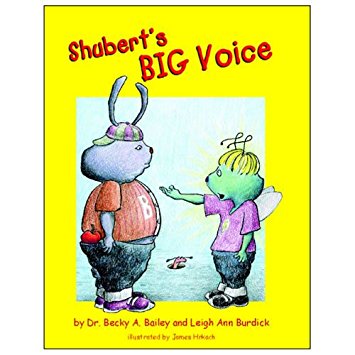Shubert's Big Voice
Author: Dr. Becky A. Bailey and Leigh Ann Burdick
Illustrated by: James Hrkach
Recommended for Ages: 4 and up
About: Assertiveness
It is the first day of school and Schubert is very excited about meeting his new teacher, Mrs. Bookbinder. He takes a big, shiny apple as a welcome gift for her. After Schubert arrives at school he is accidently knocked over when a classmate, Benny, pushes the door open. This causes the apple to fall out of his backpack. Benny picks it up, and won’t give it back. Mrs. Bookbinder sees that Schubert is mad, and that he does not know the words to use so that Bennie will hear him and give his apple back. She approaches Schubert gently and helps him calm down. She then coaches him on how to use his ‘Big Voice’ (including body language and tone of voice). Schubert practices with Mrs. Bookbinder until he feels confident enough to approach Bennie, express his feelings, and tell him to give his apple back. Schubert is overjoyed when his ‘Big Voice’ works and Bennie hands the apple back to him. “Wow! My words have power!” he exclaims over and over again.
The acquisition of social skills is an important developmental milestone for children in pre-school and kindergarten. Schubert’s Big Voice resonates with children this age, who will often ask teachers to read the story over and over again. Each time the story is read, teachers are walked through the steps involved in coaching children to stand up for themselves. Once armed with these skills, teachers can begin to use classroom conflicts as ‘opportunities’ to engage individual students in learning to use their own ‘Big Voice’.
Schubert’s facial expressions are easy to read and can be used to lead into discussions about assertiveness and feelings. Teachers can ask ‘wondering’ questions such as “I wonder how Schubert is feeling right now?” or ‘open-ended’ questions like “When you see Schubert sitting with his arms crossed and his forehead wrinkled, what do you think he is feeling?” This could be taken this one step further by asking individual children to demonstrate how their own body would express this feeling – i.e., “How does your face look when you are mad? Does it look like Schubert’s?” “Can you show us your ‘mad’ face?” or “How would your arms look if you were angry? Would you fold them like Schubert or do something different with them?” Discussions about body language and tone of voice help children learn to recognize their own feelings and those of others.
A game of ‘Feelings Charades’ is another good way to help children learn about body language and facial expressions. Cut the individual faces out of a ‘Feelings Faces’ poster and put them into a basket. The children take turns drawing a feelings face from the basket and act it out while their classmates try to guess what that feeling is. The CSEFEL website ( http://csefel.vanderbilt.edu/index.html ) has a feelings faces poster that can be printed out.
Reviewer: Elizabeth Rhoades MS.
Early Childhood Consultant
Early Childhood Consultation Partnership


